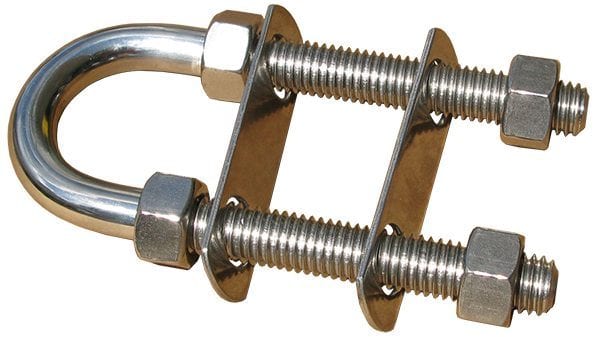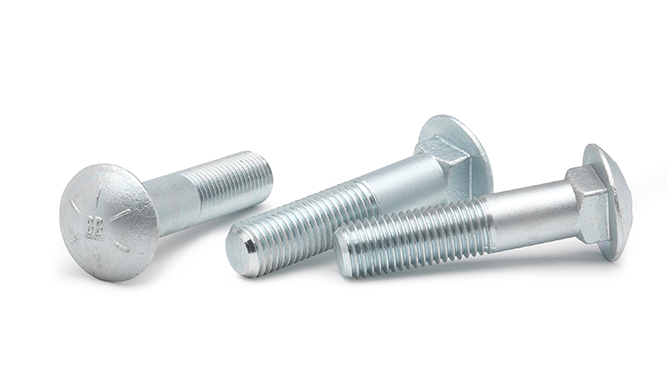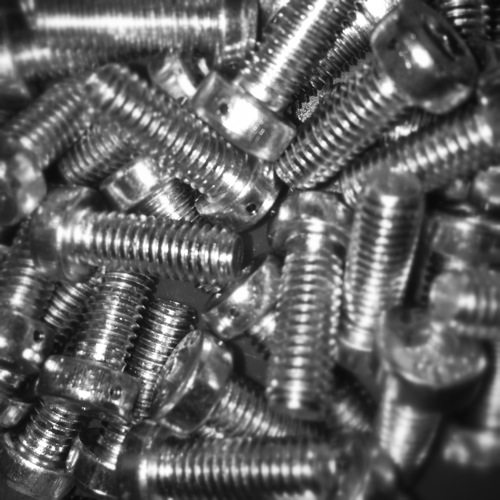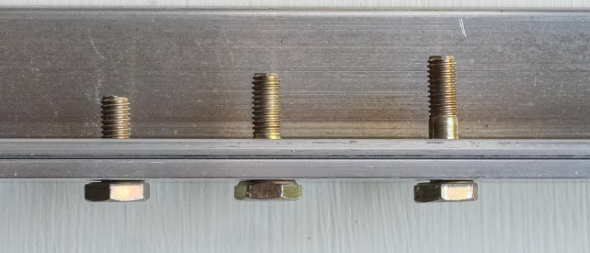
7 Basic Types Of Fasteners
7 basic fasteners include bolts, screws, nails, rivets, anchors, washer,and clips for various applications.
Screws: Essential Components in Fastening
Screws are the most common fasteners that have practically no limitations as to their application and strength. There is a wide range of screws available on the market, and each type is designed for specific purposes. The knowledge of the types of screws and their application areas is necessary to use the fasteners effectively for purposes of assembly and construction.
Types of Screws:
Wood screws are designed to fasten wood; they have coarse threads and sharp points. Available sizes range from #2 tp #24, and the length varies from 1/4 inches to 6 inches.
Machine screws require nuts or tapped holes, and their threads are finer than those of wood screws . Their size range from #0 to 3/4 inch, and they can be used for a wide variety of machinery and electronic equipment .
Sheet metal screws are designed to join thin metal sheets; they are provided with sharp threads and often have sharp points as well. Their size range from #2 to 3/8 inch, depending on the metal thickness.
Applications and Examples:
Woodworking: wood screws are used to attach lumber and when woodworking is performed, e.g., assembling shelving units, sturdy cabinets, or picnic tables.
Construction: screws are indispensable for frame construction, drywall, and roofing applications. For instance, screws are used as fasteners attaching a drywall or gypsum to metal or wood studs.
Electronics: machine screws are extensively used for mounting equipment in electronic devices, e.g., hard drives, mainboards, or cooling fans . The mainboard must be assembled into a computer case by machine screws.
Installation Process:
Pre-drilling: to perfectly align the screw, drill pilot holes of a smaller diameter of the screw’s shank; this will prevent the wood from splitting.
Driving: the screw can be rotated using a manual screwdriver or a machine. Drive the screw deeply enough to guarantee the connection; avoid overtightening the screw.
Countersinking: to hide the screw in the surface, bore a contersink; this will ensure a flush surface and aesthetics and safety.
Maintenance and Considerations
Corrosion resistance: use screws with coating for protection against corrosion and weather. Zinc-plated or stainless-steel screws are suitable for outdoor use.
Torque specifications: never overtighten the screw; use manufacturer’s recommended torque values.

Commercial and Custom Bolt Supplier
Nails: Traditional Fasteners for Secure Connections
Nails have existed as fasteners for centuries due to their simplicity and reliability of use. Where several types of nails are available, the knowledge of these types and their use is paramount for strong and durable connections.
Types of Nails
Common nails : These nails feature a smooth shank and a flat head. They are used for general building purposes. They are available at a size range between 2d and 60d . The sizes of the several diameters of these nails range correspondingly.
Finish Nails : These nails are different from common nails due to their smaller head sizes and thinner shanks. They are used for minimal surface effect since they can be driven deeper than the material’s surface than the others. Their sizes range from 2d to 20d .
Roofing Nails : These nails are specifically designed for the roofing purpose. To compliment this design, they have large heads, which are flat to penetrate the shingles . They have spirally or ringed shanks. They are available in sizes that range between 1 inch and 3 inches . These nails are either galvanized or have other types of coatings to ensure they are not affected by the weather.
Applications
Construction Framing : Common nails are indispensable in the construction of houses or any other building. They support the whole structure securing the studs, joists, and rafters.
Carpentry and Woodworking : Finish nails are used in this category for work such as trim assembling, furniture framing, and other works . They are useful in such operations due to low surface distractive damage that can be repaired using putty or wood fillers.
Roof Installation : Roofing nails are the only available nails used in the roofing operation. They are needed in the putting up of the roofing shingles on the roof deck .
Installation Process
Selecting the type and size of a nail : the decision is based on the nail types that is appropriate on the type of the material and the process used.
Positioning : Positioning the nail at the point one wants to attach to the other material making the structures t to be attached firm.
Driving the nail : For common and roofing nails, use a hammer to drive the nail deep and firmly. For finish driving, use finishing to drive the nails much deeper than the other to make the finish be even with the other surfaces.
Conclusion
Nails are destined to remain one of the simple and reliable fasteners for centuries. However, to make the most out of them, knowledge of the types and their uses. Additionally, the maintenance and associated process are useful in ensuring the nails serve us for longer.
Nut: Essential Components for Secure Fastening
Nuts are integral fastening devices that interact with bolts and screws to form a strong and reliable connection. It is important to understand their types, sizes, and installation characteristics to secure proper fastening.
Types of Nuts:
Hex Nuts: The most common type, presenting six flat sides, and internal threads. They vary in size from #2-56 to 4 inches and are made of steel, stainless steel, or brass.
Nyloc Nuts: These nuts include a nylon insert that enhances the grip across threads and prevents loosening due to vibration or torque. Nyloc nuts range from #4-40 to 3/4 inch.
Wing Nuts: Wing products feature two outward “wings” and are hand tightened for fast disassembly. They are available in sizes of #6-32 to 3/4 inch.
Applications and Examples:
Machinery & Equipment: One of the most common applications of hex products refers to the machinery. Bearings, gears, and pullers are secured from the shafts or axles using nuts.
Automotive & Transportation: Nyloc nuts are abundant in the manufacturing of automobiles. Local transmission tunnels, suspensions, and engine mounts require the support of constant fastening even during harsh driving conditions.
Household Items: Finally, wing nuts are most commonly used on furniture pieces that are often assembled and disassembled. File cabinets, for example, are assembled in flat boxes and require easy and inconvenient assembly, offered by wing.
Installation Instructions:
Selection of the right size and type according to the corresponding bolt and as demanded by leaning options of specific applications.
Internal threading of the nut should always align with the external threading of the bolt.
Manual first capping is required, so the nut or bolt/screw is not fully tight but rather snug and does not rotate freely.
Never overtighten so the nut should hands correctly on the shaft or fixture and finally use a socket or a wrench to implement the demanded level of tightness.
Maintenance & Final Considerations:
Best results are achieved when products present the same threads and pitch.
The demand and implementation of provided torque level are used to maximize the fastening options that are not too loose nor damaging in rotational movement.
Bolt: Key Element in Structural Integrity
Bolts are irreplaceable fasteners used in dozens of industries to create reliable and strong connections. It is important to understand the various types of bolts, their size and the correct application procedure to make sure that the connection is intact and safe for people and property. As for the type of bolts, the following exist:
Hex bolts. This type of bolts is perhaps the most commonly used and is applicable to construction, machinery and automotive industries. It features a hexagonal head and a threaded shaft. The size depends on the diameter of the bolt: it may be as small as 1/4 inch and reach 1 inch. Length also varies.
Carriage bolts. This type is characterized by a round, smooth head and a square neck underneath. The bolts are used to fasten wood to either wood or metal or in case a construction requires a smooth head finish. The diameter of such bolts is usually 1/4 to 3/4 of an inch, and their length varies as well.
Eye bots are threaded on one half of the shaft and have a looped element on the second. This type is used to attach various cables, hooks, and other types of hardware to lift or securely attach heavy objects. The size of the eye bolt and its material depend on the area of application.
As for the application and examples of bolts types of strikes in different areas exist:
Structural construction.
Outdoor structures. In the case, carriage bolts are commonly used for structures constructed outside or exposed to outdoor weather.
The marine industry.
The general installation procedure includes:
Drilling the hole of the appropriate size;
Inserting the bolt through the hole;
Adding washers to the bolt and securing the connection with a nut.
Torque should be used not to overtighten the bolt. It will either damage the material or cause it to easily disengage. Regular inspection is also mandatory.
Washer: Enhancing Fastening Efficiency
Washers are often underrated and unnoticed, yet they play a crucial part in any fastening system. They are supposed to accomplish several functions simultaneously while ensuring long-term secure connection between the surface and the attached part. This fact makes understanding different types, purposes, and usage of washers very important for any person using them for fastening different types of surfaces, parts, and other elements.
Types of washers:
Flat washers. The simplest design, so flat washers serve as buffers. They are connected to a bolt to provide extra friction preventing a bolt from coming undone or tightening. In other words, the function of flat washers is to distribute the load to a wider area.
Lock washers. Made to prevent nuts and bolts from loosening due to temperature changes or vibrational shifts, these washers look similar to the previous type but have a curve and tabs. They differ in design and purpose and are intended to provide extra safety securing the bolt.
Spring washers. Also known as disc springs or Belleville washers, they provide flexibility and create and maintain tension or load on the assemblies subject to dynamic loads or thermal expansion.
Applications and examples:
Heavy machinery. Flat washers are used in different structures of heavy machinery to provide enough tension and distribute the load between two surfaces. In some cases, washers can serve as safety washers to prevent surface damage, for example, giant ball-bearing parts.
Automotive industry. Lock washers are frequently used in vehicle assembly. For example, such parts are essential for securing the engine mount to avoid premature disintegration taking the essential locks apart. They are also used in the vehicle’s suspension and brakes to keep the heavy vehicular parts tightly connected.
Electronics. Spring washers or disc springs find their applications in making different electronic devices and home appliances safe and reliable. The devices heavily using spring washers are usually connected via wires and have PCBs and screw terminals.
Anchors: Secure Fastening for Various Surfaces
Anchors are tools or fasteners which are used to make an attachment of different objects to surfaces like concrete, drywall, and masonry. They’re simply a broad category of fasteners. Whether you are handyperson or a trade professional, there are many different types of anchors and getting a good understanding of what is out there and how they work can help you achieve the best possible attachment. This will keep the connection reliable and long-lasting.
Types of Anchors
Concrete Anchors. They include many types of fasteners which are designed for concrete or masonry. Wedge anchors, sleeve anchors, and expansion anchors are a few examples. They provide strong fastening for structural and heavy-duty applications.
Drywall Anchors. Plastic expansion anchors, toggle bolts, and self-drilling anchors are some of the many types of anchors designed to use with drywall or gypsum board. It can hold light and medium-weight objects without damaging the wall.
Wall Anchors. This is a catchall category of anchors. They are made for use on different wall surfaces, ranging from wood and metal studs to plaster. Hollow-wall anchors, molly bolts, and butterfly anchors are examples of this type of anchors.
Applications
Construction. Many construction projects make heavy use of this big category of fasteners. Concrete anchors are used to attached structural elements like beams and columns or equipment mounts into concrete foundations or walls.
Home. Whether you’re a frequent DIY-er or only do the buffet occasionally, many homes have some sort of wall attachment in them. It could be a mirror, a picture, a television, or shelves. Drywall anchors can become your best friend.
Commercial. In office buildings and retail spaces, there are all sorts of things attached to walls including signs, display fixtures, and lighting fixtures.
Installation Process
Choose the Right Fastener. Find the anchor which matches the base material and the weight of the connection.
Drill the Hole. Ensure the hole is clean and clear of debris for best anchor performance.
Insert the Anchor.
Tighten the fastener securely. Over tightening may strip out the hole or strip the threads.
Maintenance and Consideration. Keep in mind the weight rating or load of an anchor and match it to the expected load. Also, ensure the base material can anchor team in the first place.

Custom Made Screws Archives
Rivets: Permanent Fasteners for Metal Structures
Rivets are mechanical fasteners designed to create permanent connections between metal sheets and structures. The rehabilitation allowance of all three types of rivets are presented to the understanding that when the assessment card is applied, the time for reviewing letters is absent. It is important to be aware of the types of rivets, as well as the process of their installation for creating a strong and durable joint. Learning Objectives: Identify the types of rivets and their installation; Practice safe installation use of a blind rivet Installation.
Types of Rivets
Solid Rivets. Solid rivets are permanently joined to a given material and a part of the material itself. The process of installation consists of turning the material by deforming the shaft, is installed.
Blind Rivets. Blind rivets or pop rivets are installed from one side of the workpiece. They provide a simple and convenient way to join materials where access to the back side is limited.
Tubular Rivets. They are joined together in a workpiece to enable them to be removed. Tubular rivets are key to the mechanism of leather making, shoes, and luggage.
Applications and Examples
Aerospace Industry. Aerospace industry extensively uses solid rivets for construction, for example, joining wing spares, fuselage frames, and engine mounting. This application provides robust, reliable joints.
Automotive Manufacturing. Blind rivets are actively used in manufacturing for joining body panels, chassis parts, and interior elements. This process is used to avoid assembly problems and reduce car-building time.
Metal Fabrication Tubular rivets are installed in the metalworking industry where thin sheets of metal are joined together, for example, to make guide signs, light, and decorative items.
Installation Process
Preparation. Determine the type and size of the rivet based on the thicknesses of the material and the needs of the connections. In addition, a rivet is properly ready for use.
Drilling or Punching. The workpieces are primed by drilling or punching holes where they will be used for rivets.
Insert deviates sufficient from the surface into the application location and ensure that the deviates are in the correct higher position.
Setting. Use a deviates or pneumatic deviator to reposition the time to create a tight permanent connection in the conduct of the radio or material.
Maintenance and Considerations
Proper Joint Strength: Determining the diameter of the rivet and the materials used in the expansion must be chosen correctly to ensure that the applied strength is met.
Regular Monitoring: Regularly check the rivets’ case and the district as studies must be able to replace them with studies in the joints on wear, fatigue, or rivets and replace weary ones.



